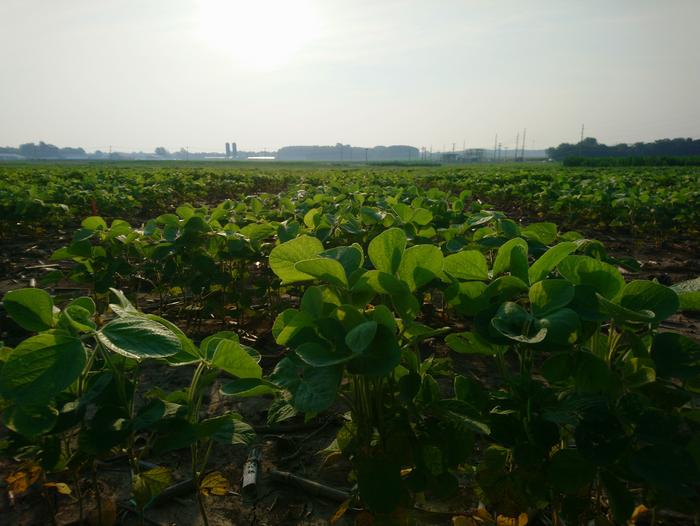A groundbreaking study from researchers at the University of Illinois has unveiled significant insights into the realm of soybean photosynthesis, highlighting the limitations of traditional breeding methods and suggesting a promising future with gene editing technologies. The research, conducted over three years, has crystallized the understanding that optimizing the soybean photosynthetic process is essential for enhancing yield potential, an endeavor that is increasingly critical in the face of global food demands.
The underpinning of this research began with an exploration of photoprotection mechanisms—the plant’s ability to manage excess energy absorbed during high light conditions. While photosynthesis is a process honed by millions of years of evolution, current agricultural practices have revealed that natural photoprotection processes in soybeans may not be fully optimized for modern cultivation environments. According to Steven Burgess, an assistant professor in plant biology, the existing genetic diversity found through traditional breeding may not provide the enhancements needed to increase soybeans’ light-harvesting efficiency.
Notably, the study aims to confirm prior computational models that suggested potential avenues for improving photoprotection through genetic interventions. The research suggests that the inefficiencies arise particularly when soybeans are subjected to variable light conditions, such as shade from clouds or neighboring foliage. These fluctuations complicate the plant’s ability to efficiently handle excess energy, leading to lost growth opportunities and reduced yield.
The detailed measurements taken throughout the growing season were pivotal for this research. Burgess and his team meticulously collected data at six critical growth stages, pairing it with environmental variables such as temperature, rainfall, and solar irradiance. This holistic approach allowed the researchers to uncover variations in the relaxation of non-photochemical quenching among different soybean varieties, effectively mapping how well various genotypes perform under real-world agricultural conditions.
Statistical analyses indicated significant diversity in the ability of selected soybean genotypes to adapt their photoprotective responses. Therefore, the research not only reiterated the inadequacies of traditional breeding but also illuminated the promising horizons that gene editing techniques can offer. These revelations play a crucial role in the ongoing quest to enhance staple crops like soybeans, which are vital for food security and nutrition across the globe.
As the research aligns with the broader aims of the Realizing Increased Photosynthetic Efficiency (RIPE) project, it is important to contextualize the significance of gene editing in advancing agricultural biotechnology. The RIPE initiative, supported by significant funding agencies, including the Gates Foundation, focuses on employing innovative strategies to improve photosynthesis in crops, enhancing their productivity without requiring additional land or resources.
Burgess’s findings challenge the boundaries of plant breeding, making a strong case for transgenic and gene editing methodologies as feasible solutions to the obstacles currently faced by growers. The ability to manipulate genetic factors that control photoprotection could unlock new pathways for improving yields, thus addressing both food scarcity and environmental sustainability challenges.
It is crucial to note that this research does not exist in a vacuum. The implications resonate within the larger discourse on food security, environmental sustainability, and technological advancements in agriculture. Amidst climate change concerns and an ever-growing population, enhancing crop efficiency through scientific innovation represents a proactive approach to ensuring food availability for future generations.
Furthermore, as various stakeholders, including policy-makers, farmers, and consumers, engage in this ongoing dialogue, the importance of transparent science communication becomes paramount. As public understanding of gene editing evolves, fostering an open dialogue regarding its implications and benefits will be essential in garnering support for agricultural biotechnologies.
With the publication of these findings in a peer-reviewed journal, the research contributes valuable data to the scientific community and sets the stage for future investigations that explore the intersections of genetics, plant physiology, and agricultural practices. As we continue to push the boundaries of what is possible through plant science, the stakes only grow higher in our shared endeavor to feed the world sustainably.
As scientists, regulatory bodies, and advocates come together to navigate the complexities of gene editing legislation, the insights provided by Burgess and his team will be instrumental. Their pioneering efforts encapsulate both the challenges and opportunities facing modern agriculture and herald a future where gene editing could empower crops like soybeans to outperform their traditional counterparts.
By understanding and harnessing the intricacies of photosynthesis and photoprotection systems, researchers are unlocking the door to a new era of agricultural productivity that leverages the best of both natural genetic diversity and biotechnological innovation. As we stand at the precipice of these advances, the implications will reverberate through our food systems for generations to come, making this research a cornerstone of future explorations in crop science and genetic innovation.
—
Subject of Research: The optimization of soybean photosynthesis through gene editing
Article Title: Unlocking Soybean Potential: The Promise of Gene Editing in Enhancing Photosynthesis
News Publication Date: Not applicable
Web References: Not applicable
References: Not application
Image Credits: RIPE project/Danny Gotarkar
Keywords: photosynthesis, gene editing, soybean, photoprotection, agricultural biotechnology, CRISPR-Cas9, crop enhancement, food security, plant breeding, genetic diversity, sustainable agriculture, environmental stress
Tags: agricultural practices and food demandscomputational models for plant biologyenhancing light-harvesting efficiencygene editing technologies in agriculturegenetic diversity in soybeansmodern cultivation environmentsoptimizing soybean yield potentialphotoprotection mechanisms in plantssoybean photosynthesis efficiencytraditional breeding methods limitationsUniversity of Illinois soybean researchvariable light conditions impact





